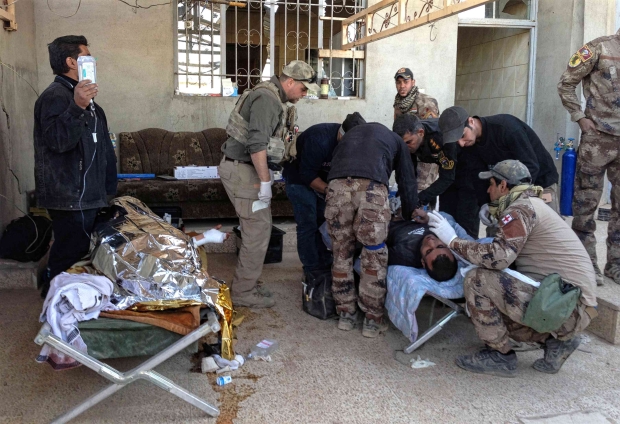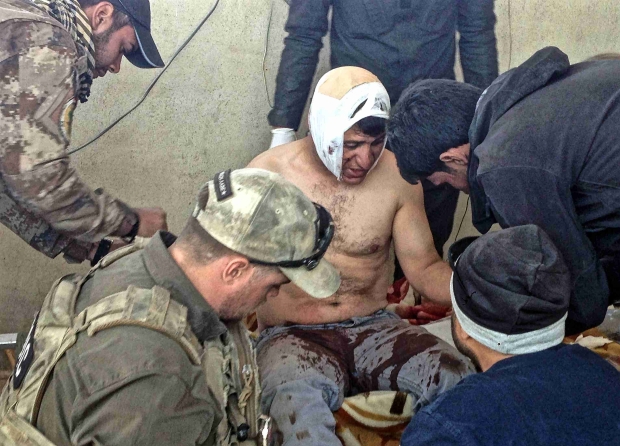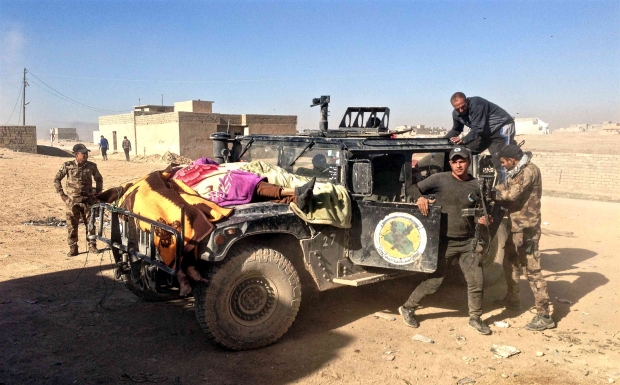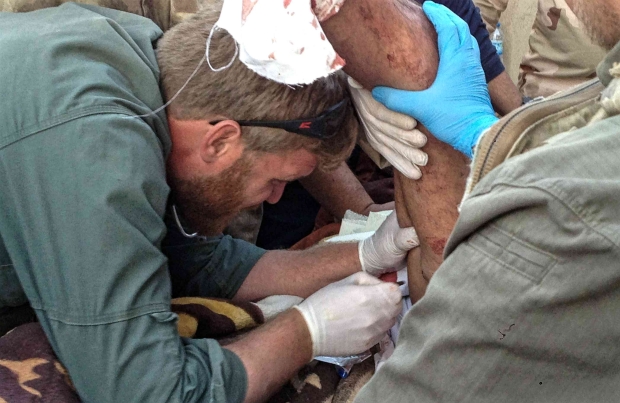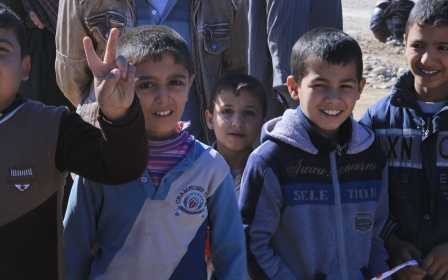Battle for Mosul: A day in the life of a field hospital
An armoured Humvee hurtles out of eastern Mosul at speed. It veers past fleeing civilians, sounding the horn and screeching to a halt outside the field hospital.
The day’s fighting has begun, bringing with it the first casualties.
Soldiers, white with masonry dust from the explosion of an Islamic State (IS) mortar, pile out and lift wounded civilians from the vehicle. A teenage girl, her face heavily bandaged, is carried inside. She is silent but her mother wails inconsolably, crying: “A mortar, a mortar, my girl, my child.” The medics unwind bandages to reveal a jaw laceration, around which her face is already swelling. While one stems the bleeding, another cuts off hunks of her blood-clotted hair to better access a deep head wound.
On the adjacent bed, another man lies on his side, veined intestines bulging out from a shrapnel wound.
READ: Islamic State told me to spit on the crucifix
A man outside can be heard shouting: “My daughter, my daughter, she lost both her arms. A curse upon Daesh. A curse upon them.”
On a camp bed, a small boy sits cross-legged, wrapped in a metallic space blanket, watching the chaos unfolding around him with an expressionless face.
The medics work. More wounded arrive
These are the Mosul civilians caught up in the city’s violent battle between IS militants and Iraqi armed forces. Living on the front lines, they are under constant threat of a stray IS mortar, the huge explosion of a car bomb in a narrow nearby street or sniper-fire if they venture outside their gates. Chief medic Captain Nizar Jawad tells MEE that the field hospital, in the city’s Gojelli suburb, treats an average of 75 to 100 civilians every day.
Even while medics are stabilising patients, patching up wounds sufficiently to transfer them to Erbil hospital – a two-hour drive along 86km of battered, war-scarred tarmac – more Humvees arrive.
Another Humvee. More soldiers. Some are carried, others half dragged in, held up by comrades. As clothing is cut away, rough bandages removed and IV drips fitted, the air fills with noise – screams from the injured, medics shouting for dressings, asking for soldiers’ names. The critically injured are silent. The medics work fast, blood dripping on to the tiled floor among soaked bandages and torn clothing.
READ: Escape from Mosul: Liberation, desperation, interrogation
Two young soldiers have mortar shrapnel in their legs. One lies on a camp bed, the other props himself up on the floor nearby, removing his friend’s scarf and smoothing sweat-drenched hair back from his forehead, whispering words of comfort. Their wounds are treated briskly and his friend is shifted on to the floor beside him, to make way for another soldier, blood pouring from his arm, despite the makeshift tourniquet secured around his bicep with a stick. The two soldiers with their legs bandaged lean against one another, sharing cigarettes in the silence of shock.
As fast as the medics can work, more wounded are arriving. More soldiers and more civilians. They are running out of saline solution for the drips.
Preserving dignity, even in death
Among the casualties, there is little time to give attention to the dead. An abandoned Humvee stands outside the field hospital, its doors still open from the desperate scramble to get the wounded out. On its bonnet lie three civilian corpses, wrapped in blankets. The feet of one man protrude from a brightly coloured blanket, crossed at the ankles as though in rest. Blood from another drips through the engine of the Humvee, pooling on the sand beneath.
The walking wounded are being helped into ambulances, where they are propped up on bench seats. Stretcher cases are laid on the floor of the older ambulances. When there are no more ambulances, the wounded are loaded into a military vehicle.
READ: US volunteers treating patients on the front line clinic
“We’ve already treated 40 patients today. At least half were in a critical condition, but we saved their lives,” says 33-year-old Slovakian medic Marek Adamik, one of a team of six volunteer medics working for the Slovakian NGO Academy of Emergency Medicine. They are the only international medics working in Mosul.
“Most injuries are ballistic, from mortars and other explosives, or from snipers,” he said. “And sometimes there are amputations, if a soldier has stepped on a mine, or if a house has taken a direct hit from a mortar.”
'There are highs and lows, peaks and valleys'
A tiny three-wheeler truck veers towards the hospital, a white flag fluttering above it. In the back, a man in a pink T-shirt soaked in blood cradles a boy in his lap. Blood gushes from the boy’s face and he yells in pain as the medics try to clean the wound. The man in the pink T-shirt crouches on the ground outside, weeping, his face contorted in grief-stricken agony.
Even before staff have finished washing the blood from the floor, another Humvee arrives carrying 37-year-old Shahlan, shot by a sniper. He clenches his teeth in silence as American Pete Reed, the chief medic for the Slovakian NGO, uses a scalpel to cut out a bullet head lodged in his calf. Reed tucks the bullet into Shalan’s shirt pocket, and lights them both cigarettes.
“There are highs and lows, peaks and valleys, and that was a peak,” says Reed. “The valleys are the patients who don’t make it. That happens a lot and more than half of those are civilians.”
The flow of casualties ceases as the sun sets and the field hospital falls silent. Medical staff restock supplies in the courtyard. Outside others set alight the heaps of bloodied bandages and clothing they have piled up during the day.
This article is available in French on Middle East Eye French edition.
Middle East Eye propose une couverture et une analyse indépendantes et incomparables du Moyen-Orient, de l’Afrique du Nord et d’autres régions du monde. Pour en savoir plus sur la reprise de ce contenu et les frais qui s’appliquent, veuillez remplir ce formulaire [en anglais]. Pour en savoir plus sur MEE, cliquez ici [en anglais].


